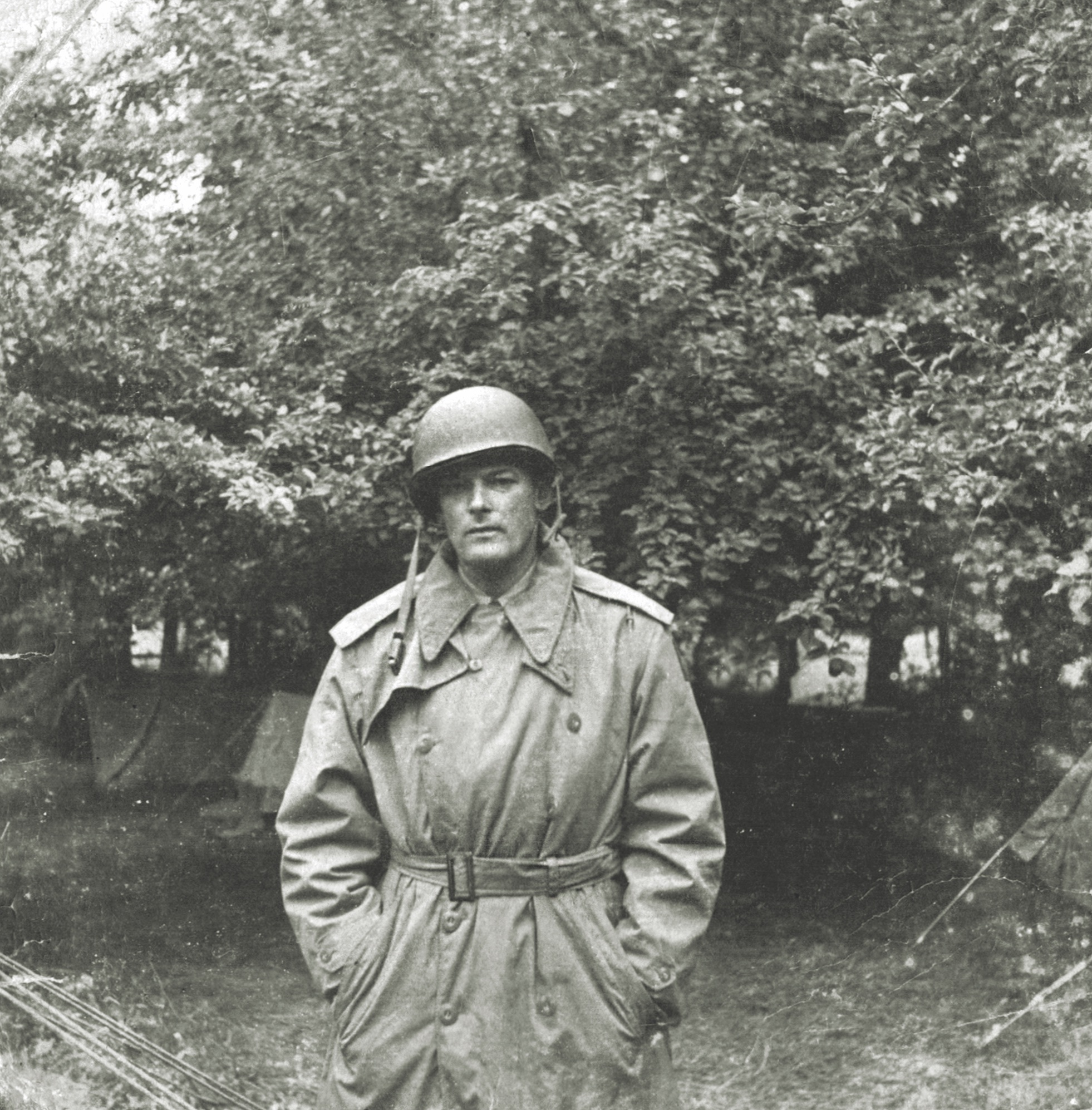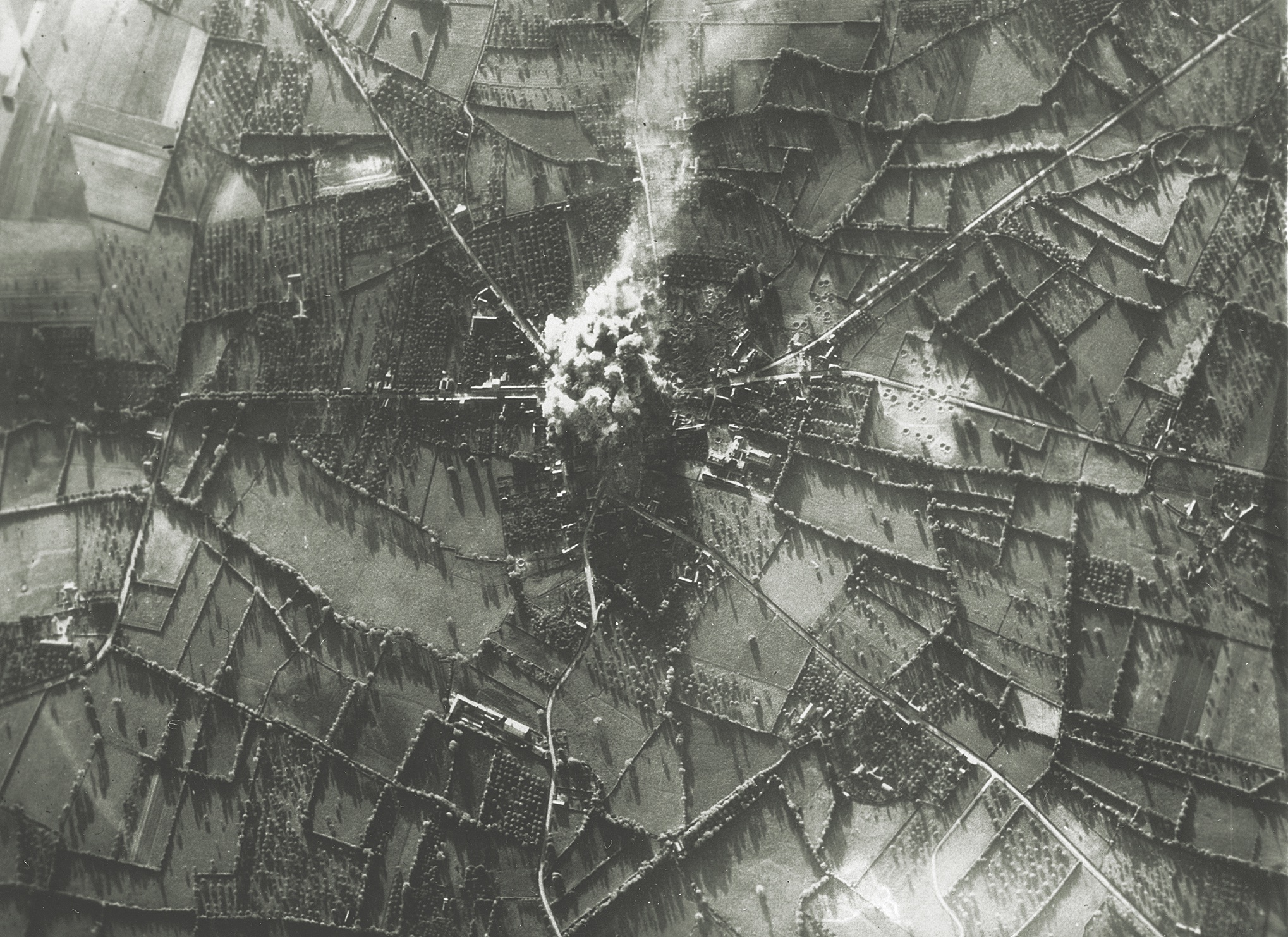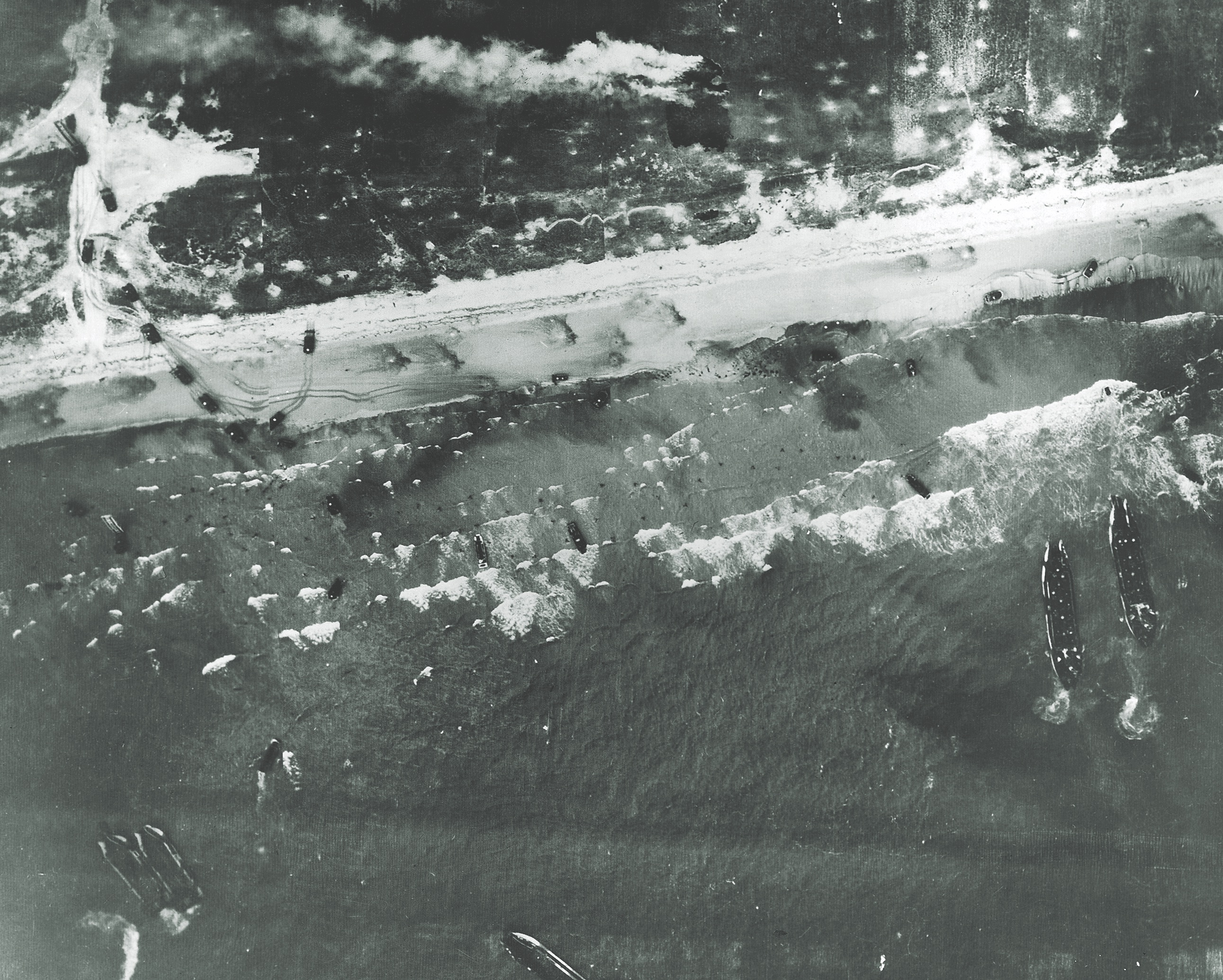Roelif Arthur Loveland was born in 1899 in Oberlin, Ohio. Just as he was finishing high school the United States entered World War I, and he decided, at age 18, to enlist in the U.S. Marine Corps. While serving with the American Expeditionary Forces in France, he was wounded and gassed in the bloodiest fighting the AEF would see in the war: Belleau Wood, Soissons, Saint Mihiel, and, finally, in the Meuse-Argonne. After the war, Loveland attended Oberlin College and then settled on a career as a newspaperman. In 1922, following a brief stint at the Cleveland Press, he landed a job at the Cleveland Plain Dealer, which would be his professional home for the next 42 years.
Loveland made a name for himself writing “color” pieces (as well as occasional verse), and in 1944 the Plain Dealer sent him to Europe to report on the Allied invasion of France. After landing at Normandy, Loveland covered Lieutenant General George S. Patton Jr.’s Third Army as it swept through northern France. He often shared a jeep with Ernest Hemingway, who was also following Patton’s army as a war correspondent. Loveland made it a point to include soldiers from the Cleveland area in the dispatches that he filed almost every day; in this he was taking a page from Ernie Pyle, the famous correspondent for the Scripps-Howard newspaper syndicate, whom he met in London and greatly admired. Loveland was one of the first correspondents to set foot in liberated Paris, and he followed the Third Army to the German border before he was recalled to the States by the Plain Dealer.
Once back home, Loveland spent a year covering the Cleveland Indians baseball team for the Plain Dealer. He was then made an associate editor and soon after that became an editorial writer and columnist. He died in 1978 at age 78.
In 1979 Philip W. Porter, Loveland’s longtime editor at the Plain Dealer, compiled and edited an anthology of his overseas dispatches, columns, and editorials. “After a lifetime of writing, I concluded after reviewing Loveland’s work that I really don’t know how to write,” Porter wrote in the foreword to the book. “Loveland did. He was one of the greats, possibly the greatest.”
On June 6, 1944, Loveland joined First Lieutenant Howard C. Quiggle, a fellow Clevelander, aboard a
Martin B-26 Marauder on a bombing mission in support of the D-Day invasion. His eyewitness account of the invasion—one of the first such stories to appear in an American newspaper—ran the following day on the front page of the Plain Dealer. It is reprinted here with the permission of the Plain Dealer.
A NINTH AIR FORCE MARAUDER BASE IN ENGLAND, June 6—We saw the curtain go up on the greatest drama in the history of the world, the invasion of Hitler’s Europe.
We saw it from a balcony seat high up in God’s heaven, in a combat-bound Marauder piloted by a Cleveland boy, First Lieut. Howard C. Quiggle, 17118 Lipton Avenue S.E. Flak flew about us and tracer bullets missed us by uncomfortable margins, but our bombardier dropped 16 250-pound bombs on military installations near the area in which our troops were to come ashore for the invasion.
Being only one of thousands riding the tail of a comet to see history in the making leaves a witness drained of all emotion and too numb to be very articulate.
How can words describe properly the deathless bravery that the world saw on the shores of France? How can words describe properly a sky filled with planes, fighters, bombers, risking life itself to give the infantry the best possible chance to succeed. What magnificent teamwork!
They called us out of bed early this morning. It’s a little difficult to eat at such a time. Briefing took place soon after. Some of the boys still thought that it was a dry run and that they would be told to go back to bed.
But they changed their minds when Col. Richard T. Coiner, commander of this station, started off by reading a letter from Gen. Dwight Eisenhower in which the general commended the Ninth Air Force for splendid work in the past and exhorted the men to give their very best to the task at hand.
Then Brig. Gen. Samuel Anderson, commanding general of the Ninth Bomber Command, walked to the front of the briefing room and the elite group of fighting men stood up at attention.
The general told them that the work for the immediate future would be hard and they must all draw on hidden strength which always seemed to come to American fighting men when they had need of it. He told them that they would have to fly many missions every day and that their success in destroying enemy points would have a real effect on the length of the war.
“This, gentlemen, is it,” said Col. Coiner. “We are to spearhead the invasion.”
Then the chaplain, Capt. Clarence R. Comfort, led the men in prayer and every head was bowed. They did not know what they would be facing exactly, but they feared it would be pretty tough and they wanted to act like men whether they were scared or not. The briefing was unusually long, in itself an indication of something or other.
The fliers did not wear shining armor when they went out to their planes, the sleek, deadly, Marauders. They looked bulgy, and no man can look otherwise who is wearing a Mae West life preserver, a parachute, a flak suit, earphones and a flak helmet. Before we got into the plane we had to remove all personal letters and such. I was assigned by choice to Lieut. Quiggle’s plane, the Dottie Dee, named after his wife. When you start out on a strange adventure at that time in the morning you sort of like to be with a hometown boy. It’s kind of scary, no fooling.

The moon was in the sky when we started, and it followed us all along, and presently we were riding over clouds which looked like cotton wool of a lavender color. I can’t imagine that heaven could be more beautiful. But angels probably would ride the clouds better than we could have done if the Dottie Dee had not been purring along sweetly.
Purring is a bad word. The Dottie Dee roars, but your earphones sort of dim the noise. When you are in a fighting plane advancing toward the enemy the plane becomes your one little world and none of the sweet things of life exist any more. And your fellows become the most important people in the world, even more important to you than Mr. Churchill or Mr. Roosevelt.
Sergt. William J. Burns, 36, of East Hartford, Conn., went to his position as tail gunner. Sergt. James W. Russell, 21, of West Monroe, La., went to his spot as waist gunner.
Lieut. Quiggle, of course, was piloting the plane, and Second Lieut. Anthony V. Petraitis of Scranton, Pa., sat beside him as co-pilot.
Sergt. Edwin Rodie, 23, of Fresno, Calif., was manning the top turret gun, and Second Lieut. J. W. Goodwin, 26, the bombardier of Dothan, Ala., was sitting in the nose.
I stood up in front behind the pilots and watched England fade from view. And not long afterward, so perfectly had the job been synchronized, we saw the invasion ships.

The sea—the channel, if you prefer—was thick with them, as thick with ships as the sky was thick with clouds. In addition to the big landing craft were large naval vessels, and fighters were hovering over the ships, guarding them.
Nothing which could have been thought of to spare life was spared. The lads had everything which it was humanly possible to give them.
We saw our own naval vessels shelling the daylights out of German installations on the French coast. We could see the red flashes as the shells struck home. They were big shells.
Flak began to come pretty soon and tracer bullets shot in front of us like red hot rivets, but the expression on the face of the kid from Cleveland who was piloting the plane did not change in the slightest degree. He followed the course to target and then the bombardier did his stuff and the plane fairly leaped up in the air, and down below the flames shot up.
Weather was not too good, and the bombing was done from about 4,000 feet instead of the usual 12,000 feet. This is not considered particularly healthy, but it was the only thing to do.
Then we started back. We had taken off at 4:45 a.m., but by now it was light. Guns shot at us again, but missed badly. The Allied battlewagon was continuing to pour in shells, and whenever it was necessary to give the signal of our identity Petraitis took care of the matter with flares of the proper colors.
In a few minutes all danger seemed to be past. Later, when all danger was past, the sergeant with 20 missions to his credit remarked: “I’d sure hate to do this for a living.”
Daylight showed strained faces, and we got back at breakfast time.
I’m afraid this has been told badly, but I’m grateful that I was permitted to see the curtain rise on this great life and death drama. I am also kind of glad that, having seen it, I can pass along some of the impressions.
One will never forget the sight of the ships and the landing craft heading for France, any more than a knight would have forgotten the appearance of the Holy Grail. MHQ
[hr]
This article appears in the Summer 2021 issue (Vol. 33, No. 4) of MHQ—The Quarterly Journal of Military History with the headline: Classic Dispatches | Eyes on an Invasion

Want to have the lavishly illustrated, premium-quality print edition of MHQ delivered directly to you four times a year? Subscribe now at special savings!





